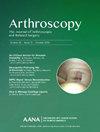在将富血小板血浆用于治疗肩袖病变的随机对照试验中,与企业有直接关联的研究更有可能报告阳性结果:系统回顾。
IF 4.4
1区 医学
Q1 ORTHOPEDICS
Arthroscopy-The Journal of Arthroscopic and Related Surgery
Pub Date : 2024-08-28
DOI:10.1016/j.arthro.2024.08.025
引用次数: 0
摘要
目的:对富血小板血浆(PRP)注射治疗肩袖撕裂的随机对照试验(RCT)结果的行业归属影响进行系统性回顾评估:方法:以 "肩袖 "和 "富血小板血浆 "为关键词,检索了 2010 年至今的 PubMed、SPORTdiscus 和 Scopus 数据库。纳入标准为将 PRP 与治疗肩袖撕裂的对照组进行比较的 RCT,排除标准为系统综述、荟萃分析、病例报告、队列研究、基础科学研究、其他 3 级及以下研究以及非英语研究。行业隶属程度分为三类:直接隶属、间接隶属和非隶属。直接隶属关系要求研究或其作者从研究中使用的制备或管理 PRP 设备的生产公司获得资金支持。间接隶属关系要求与研究中使用的 PRP 生产或管理公司有财务关联。如果研究结果显示 PRP 与对照组相比具有显著性(P < 0.05),则将研究归类为有利研究;如果 PRP 与对照组之间没有统计学意义,则将研究归类为类似研究。数据采用卡方检验和费氏精确检验进行分析:在被选中进行分析的 47 项研究中,8 项(17.0%)没有直接的行业隶属关系,9 项(19.1%)有间接隶属关系,30 项(63.8%)没有行业隶属关系。22项(46.8%)研究报告了 PRP 与对照组相比的良好结果,25 项(53.2%)研究报告了 PRP 与对照组之间的类似结果。行业隶属程度与报告有利研究结果的可能性增加显著相关(p = 0.041)。与间接关联研究相比,直接关联研究报告有利结果的可能性明显增加(p = 0.024):结论:使用由直接资助研究的公司或与作者有经济关联的公司生产的 PRP 的研究,报告有利结果的可能性明显增加:证据级别:I级和II级研究的系统综述。本文章由计算机程序翻译,如有差异,请以英文原文为准。
Studies With Direct Industry Affiliation Are More Likely to Report Positive Results in Randomized Controlled Trials for Platelet-Rich Plasma Use in Rotator Cuff Tears: A Systematic Review
Purpose
To perform a systematic review to evaluate the effect of industry affiliation on the outcomes of randomized controlled trials for platelet-rich plasma (PRP) injections in rotator cuff tears
Methods
The PubMed, SPORTDiscus, and Scopus databases were searched from 2010 to the present for the terms “rotator cuff” and “platelet-rich plasma.” The inclusion criteria were randomized controlled trials comparing PRP with controls for the treatment of rotator cuff tears, and the exclusion criteria were systematic reviews, meta-analyses, case reports, cohort studies, basic science studies, studies of Level III or below, and studies not in English. Degree of industry affiliation was categorized into 3 groups: directly, indirectly, and not affiliated. Direct affiliation required the study or its authors to receive financial support from the company manufacturing the devices used in the study to prepare or administer PRP. Indirect affiliation required financial association with a different company that produces or administers PRP than the company in the study. Studies were classified as favorable if study outcomes achieved significance (P < .05) of PRP over controls or as analogous if there was no statistical significance between PRP and controls. Data were analyzed using the χ2 test and Fisher exact test.
Results
Of the 47 studies selected for analysis, 8 (17.0%) had no direct industry affiliation; 9 (19.1%) had indirect affiliation; and 30 (63.8%) had no industry affiliation. Of the studies, 22 (46.8%) reported favorable results with PRP compared with controls and 25 (53.2%) showed analogous results between PRP and controls. Degree of industry affiliation was significantly associated with an increased likelihood of reporting favorable study outcomes (P = .041). Directly affiliated studies had a significantly increased likelihood of reporting favorable results (P = .024) compared with indirectly affiliated studies.
Conclusions
Studies that used PRP produced by companies that directly funded the studies or were financially affiliated with the authors were significantly more likely to report favorable results.
Level of Evidence
Level II, systematic review of Level I and II studies.
求助全文
通过发布文献求助,成功后即可免费获取论文全文。
去求助
来源期刊
CiteScore
9.30
自引率
17.00%
发文量
555
审稿时长
58 days
期刊介绍:
Nowhere is minimally invasive surgery explained better than in Arthroscopy, the leading peer-reviewed journal in the field. Every issue enables you to put into perspective the usefulness of the various emerging arthroscopic techniques. The advantages and disadvantages of these methods -- along with their applications in various situations -- are discussed in relation to their efficiency, efficacy and cost benefit. As a special incentive, paid subscribers also receive access to the journal expanded website.

 求助内容:
求助内容: 应助结果提醒方式:
应助结果提醒方式:


